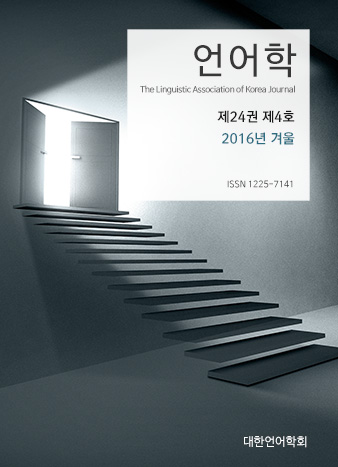대한언어학회 전자저널

-
An Alternative Approach to Realizations of the Medial [nt] Cluster in English
-
Boundary and pitch effects on the perception of Korean alveolar nasal
-
Corpus-Based English Grammar Instruction in a Korean College Context Korean College Context
-
A Study on the Relationship between Self-Efficacy Beliefs and Comprehension in English Reading
24권 4호 (2016년 12월)
Abstract
Keywords
# Key Words: negative inversion # SAI # interrogative wh-phrase focus phrase # topic phrase # OSHA # split projection
References
- Chomsky, N. (1993). A minimalist program for linguistic theory. K. Hale and S.J. Keyser (Eds.), The View From Building 20. Cambridge, Mass: MIT Press.
- Chomsky, N. (1995). The Minimalist Program. Cambridge, Mass.: MIT Press.
- Chomsky, N. (1998). Minimalist Inquiries: the framework. Cambridge, MA: MIT Occasional Papers in Linguistics.
- Edmonds, J. (1976). A Transformational Approach to English Syntax: Root, Structure-Preserving, and Local Transformations. New York: Academic Press.
- Haegeman, L. (1991). Introduction to Government & Binding Theory. Oxford, UK & Cambridge, MA, USA: Blackwell Press.
- Haegeman, L. (1995). The Syntax of negation. Cambridge: Cambridge University Press.
- Haegeman, L. & Zanuttini, R. (1991). Negative Heads and the Neg Criterion. The Linguistic Review 8, 233-251.
- Haegeman, L. & Guéron (1999). English Grammar. Oxford, UK: Blackwell Publisher.
- Klima, E. (1964). Negation in English. The Structure of Language (pp.246-323). New Jersy: Prentice-Hall.
- Koizumi, M. (1995). Phrase Structure in Minimalist Syntax. Unpublished doctorial dissertation, MIT.
- Lightfoot, D. (1989). How to Set Parameters. A New Account of Word Order Change, Paper presented at the interdepartmental research seminar in Linguistics. University of Geneva, 11 April.
- Park, S-Y. (1996). Functional Categories in English and Korean. Unpublished doctorial dissertation. Jeonbuk University.
- Park, S-Y. (2013). English Subject-Auxiliary Inversion and Split Projection. The 21st Century English Language and Literature 26(4), 355-370.
- Pesetsky, D. & Torrego, E. (2001). T-to-C Movement: Causes and Consequences. Kenstowicz, M. (Ed.), Ken Hale: A Life in Language (pp355-426). Mass, MA: MIT Press.
- Quirk, R., S. Greenbaum, G. Leech and J. Svartvik. (1985). A Comprehensive Grammar of the English Language. London: Longman Press.
- Quirk, R. & Greenbaum, S. (1990). A Student\'s Grammar of The English Language: Longman Press.
- Radford, A. (2009). Analyzing English Sentences. Cambridge: Cambridge University Press.
- Rizzi, L. (1997). The Fine Structure of the Left Periphery. Haegeman, L. (Ed.), Elements of Grammar: Handbook of Generative Syntax (pp. 281-337) Dogrecht: Kluwer.
- Rundanko, J. (1980). Toward Description of Negativity Conditioned Subject Operator Inversion in English. English Studies 68, 348-359.
- Suh, J-H. (2007). A minimalist Analysis of Subject-Auxiliary Inversion in English. English Language and Linguistics. 23, 113-132.